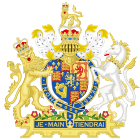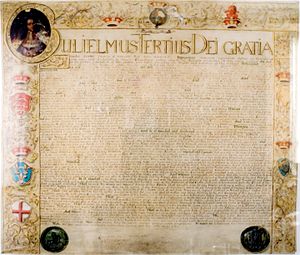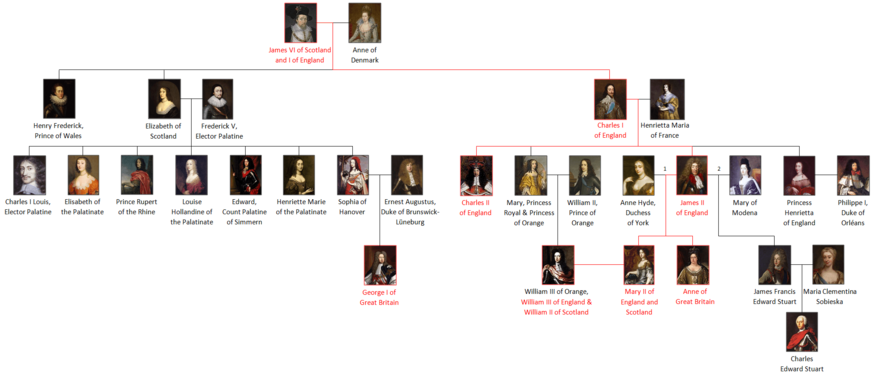Act of Settlement 1701 facts for kids
| Act of Parliament | |

|
|
| Long title | An Act for the further Limitation of the Crown and better securing the Rights and Liberties of the Subject |
|---|---|
| Citation | 12 & 13 Will. 3. c. 2 |
| Territorial extent |
|
| Dates | |
| Royal assent | 12 June 1701 |
| Commencement | 6 February 1701 |
| Other legislation | |
| Amended by |
Various
|
| Relates to | Bill of Rights 1689 |
|
Status: Amended
|
|
| Text of statute as originally enacted | |
| Revised text of statute as amended | |
The Act of Settlement is an important law passed by the Parliament of England in 1701. It decided who could become the next king or queen of England and Ireland. The main rule was that only Protestants could inherit the throne.
This law specifically said that anyone who became a Roman Catholic, or married one, could not be king or queen. This meant that other family members of King Charles I could not rule. The next Protestant in line was Sophia of Hanover. She was a granddaughter of James VI and I, and the crown would only pass to her non-Catholic children.
Sophia died just before Queen Anne. So, Sophia's son became King George I. This started the Hanoverian royal family in Britain.
Before this, the Act of Supremacy 1558 had made the Church of England separate from the Roman Catholic Church. One big reason for the Glorious Revolution was that King James II, who was Catholic, was seen as attacking the Church of England. He was removed from power. His Protestant daughter Mary II and her husband William III became rulers.
The Act of Settlement was needed because William and Mary, and Mary's sister Anne, had no children who lived. Also, there was a worry that other Catholic members of the House of Stuart might try to claim the throne.

This Act also helped create the Kingdom of Great Britain. Even though England and Scotland had shared a monarch since 1603, they were still separate countries. The Act encouraged them to unite. The Parliament of Scotland was not happy about giving up the House of Stuart, who had been Scottish monarchs for a long time.
The Act also limited the power of the monarch and the role of foreigners in the British government. Some of these rules have changed since then.
Today, the Act of Settlement, along with the Bill of Rights 1689, is still a main law for who inherits the throne. This applies not just to the throne of the United Kingdom, but also to other Commonwealth realms (countries that share the British monarch). The Act can only be changed by each country's own parliament. All the other countries must agree, as it affects the shared crown.
On 26 March 2015, new laws came into effect after the Perth Agreement. These changes removed the rule that someone could not be monarch if they married a Roman Catholic. They also introduced absolute primogeniture, meaning the oldest child, regardless of gender, inherits the throne.
Contents
Why the Act Was Needed

After the Glorious Revolution, the Bill of Rights 1689 set the rules for who would be king or queen. It said that King James II had given up the throne. His daughter Mary II and her husband William III became the new rulers.
The Bill of Rights also said that the throne would pass to Mary's Protestant children, then to her sister Anne and her Protestant children. The House of Lords tried to add Sophia of Hanover to the list, but it didn't pass.
Mary II died in 1694 without children. William III did not marry again. In 1700, Prince William, Duke of Gloucester, who was Anne's only child to live past infancy, died at age 11. This left Anne as the only person in line to the throne.
The Bill of Rights already said Catholics could not be monarch. This ruled out James II and his children born after he became Catholic. But it didn't say what would happen after Anne. So, Parliament decided to make Sophia and her children next in line. This made sure a Protestant would always be the ruler.
By 1701, people in England were worried about foreigners having too much influence. This was partly because William of Orange had brought his own foreign friends with him. So, they felt a new law was needed.
What the Act Said
The Act of Settlement stated that the throne would go to Sophia of Hanover. She was a granddaughter of King James VI and I and a niece of King Charles I. The Act clearly said that "forever" anyone who was Catholic, or married a Catholic, could not become king or queen.
Extra Rules in the Act
The Act also included eight other rules. These rules would only start after both William and Anne had died:
- Rule 1: The monarch must be Anglican. The king or queen must be a member of the Church of England. This was to make sure no Catholic monarch would rule. King James II's religion was a major reason for the Glorious Revolution.
- Rule 2: No wars for foreign lands. If a non-English person became monarch, England would not fight wars for their foreign lands without Parliament's approval. This was important because the House of Hanover rulers also governed Hanover in Germany. This rule stopped applying when Queen Victoria became queen, as she did not inherit Hanover.
- Rule 3: Monarch needs permission to leave. The monarch could not leave England, Scotland, or Ireland without Parliament's permission. This rule was removed in 1716. King George I wanted to visit Hanover.
- Rule 4: Privy Council decisions must be signed. All government decisions made by the Privy Council had to be signed by those who agreed to them. Parliament wanted to know who was making decisions. This rule was removed early in Queen Anne's reign.
- Rule 5: Foreigners cannot hold certain jobs. No person born outside England, Scotland, or Ireland (unless their parents were English) could be a Privy Councillor, a member of Parliament, or hold any important government or military job. They also couldn't receive land from the Crown. Modern nationality laws have changed some of this, but the main idea still applies.
- Rule 6: No MPs with royal jobs or pensions. No one who held a job under the monarch or received a pension from the Crown could be a Member of Parliament. This was to stop the monarch from having too much influence over Parliament. This rule is still mostly in place, but with some exceptions. For example, ministers can be MPs.
- Rule 7: Judges are independent. Judges could only be removed from their jobs if they behaved badly, and only by both Houses of Parliament. This rule was made to ensure judges could make fair decisions without the monarch's influence.
- Rule 8: No royal pardons for impeachment. The monarch could not pardon someone who had been impeached by the House of Commons. This meant the monarch could not save someone from being put on trial by Parliament.
Who Opposed the Act
The Tory government helped pass the Act through Parliament. There was little opposition, though five members of the House of Lords voted against it. Many people didn't want a "foreign" king. But the general feeling was that a "German prince" (like Sophia's son) was better than a "French one" (meaning a Catholic from the Stuart family).
What the Act Achieved
Many experts have praised the Act of Settlement. Some have called it a very important part of Britain's laws.
Union of Scotland and England
The Act of Settlement was a major reason for the union of Scotland with England and Wales. This union formed the Kingdom of Great Britain. The Parliament of Scotland was not happy with the Act. In response, they passed the Act of Security in 1704. This Act said Scotland could choose its own successor to Queen Anne.
Because of this, the Parliament of England decided that a full union of the two countries was needed before Anne died. This would ensure stability. They used a mix of laws, politics, and even bribery to achieve this within three years. This led to the Act of Union 1707. The Act of Settlement then became part of Scots law too.
Succession to the Crown
The Act excluded James II and his Catholic children from the throne. It also excluded the descendants of Princess Henrietta of England, James II's youngest sister. Her daughter, Anne, Queen of Sardinia, was Catholic. All Jacobite pretenders (those who claimed the throne through James II) after 1807 came from her line.
Since Charles I's legitimate Protestant descendants had no children (like Queen Mary II and Queen Anne) or were Catholic, Parliament chose Sophia of Hanover. She was the Protestant daughter of Elizabeth of Bohemia, who was the only other child of King James I to live to adulthood. Sophia was the oldest Protestant in that line. Parliament skipped over her Catholic siblings and their children.
Removed from Succession Due to Catholicism
Since the Act was passed, several members of the royal family have been affected. For example, Prince Michael of Kent married a Roman Catholic in 1978. He was removed from the line of succession. However, he was put back in line in 2015 when the Succession to the Crown Act 2013 came into force.
George Windsor, Earl of St Andrews, the son of Prince Edward, Duke of Kent, married a Catholic in 1988. His son, Lord Downpatrick, became Catholic in 2003 and is currently barred from the throne. His daughter, Lady Marina Windsor, also became Catholic in 2008 and was removed from the line of succession.
More recently, Peter Phillips, the son of Anne, Princess Royal, married Autumn Kelly. She was Catholic, but she became Anglican before the wedding. If she hadn't, Peter Phillips would have lost his place in the succession.
Only one member of the Royal Family (with the title Royal Highness) has become Catholic since the Act: the Duchess of Kent in 1994. Her husband, Prince Edward, Duke of Kent, did not lose his place because she was Anglican when they married.
Current Status
The Act of Settlement is part of the law in the United Kingdom. It is also part of the laws in the 15 Commonwealth realms. According to tradition and later laws, the Act of Settlement can only be changed if all these countries agree. The Succession to the Crown Act 2013 changed many parts of this Act.
Proposals to Change the Act
There have been challenges against the Act of Settlement. People have questioned the rules about Roman Catholics and the preference for males in the line of succession. Changing the Act is complicated because it affects all the Commonwealth realms. The Statute of Westminster 1931 says that any changes to the succession rules need the agreement of all the countries involved.
In 1995, Prince Charles reportedly said that Catholics should be able to become monarch. In 1998, Lord Williams of Mostyn said that the Queen had no problem with sons and daughters being treated equally in the line of succession.
Australia
In 2011, the Australian government agreed with all its states on possible changes to their laws. This was in response to proposed changes to the Act of Settlement.
The Australian constitution does not give the federal parliament power to make laws about the monarchy. So, it's not entirely clear how changes would be made there. However, when the Perth Agreement (see below) was put into law, Australian governments worked together. The states asked the federal government to pass the law for them.
Canada
In Canada, the Act of Settlement is part of Canadian constitutional law. Some people have argued that the Act's rules against Catholics are unfair. In 2002, Tony O'Donohue tried to argue that the Act violated the Canadian Charter of Rights and Freedoms. However, the court dismissed the case. It said that since the Act of Settlement is part of the Canadian constitution, the Charter does not have power over it.
The court also noted that Canada could change its line of succession. But, to keep its relationship with the other Commonwealth realms, it would need their agreement. An appeal of this decision was also dismissed.
When Peter Phillips announced his engagement to Autumn Kelly in 2007, who was Catholic and Canadian, the discussion about the Act of Settlement started again. Some argued that the Act's rules would directly affect Canada. However, Autumn Kelly became Anglican before her marriage, so Peter Phillips kept his place in the line of succession.
United Kingdom
People in the United Kingdom have debated removing the rule that stops Roman Catholics, or those who marry one, from becoming monarch. Supporters say the rule is old-fashioned and unfair. Cardinal Winning, a Catholic leader in Scotland, called the Act an "insult" to Catholics. Cardinal Murphy-O'Connor pointed out that Prince William "can marry a Hindu, a Buddhist, anyone, but not a Roman Catholic."
Opponents of changing the rule, like Enoch Powell, believe it would harm the Church of England as the state religion. They say the monarch must defend the Anglican faith and be a member of the Anglican Communion. A Catholic monarch would owe loyalty to the Pope, which they argue would mean the Anglican Church would lose its independence.
In 1999, the Scottish Parliament voted to remove all discrimination linked to the monarchy and repeal the Act of Settlement. In 2000, The Guardian newspaper challenged the law in court. They said it went against the European Convention on Human Rights. But the court rejected the challenge, as the Convention does not list the right to become monarch as a human right.
Adrian Hilton argued in 2003 that the Act of Settlement was not based on prejudice. He said it was passed because people learned that when a Catholic monarch was on the throne, religious and civil freedoms were lost. He pointed out that the Pope claims universal authority. Hilton argued it would be wrong for the ruler of a Protestant country to owe loyalty to the head of another state. He also noted that other European countries have similar religious rules for their monarchs.
In 2004, a bill was introduced in the House of Lords to change the succession laws. The government, led by Tony Blair, blocked these attempts. They said it would cause too many problems and was not needed at the time.
Across the Realms
In early 2011, Keith Vaz, a Member of Parliament, proposed changing the Act of Settlement. He wanted to remove the rules about Roman Catholicism and change the succession to absolute primogeniture (where the oldest child, regardless of gender, inherits). He sought support from Canada and other Commonwealth countries.
Later that year, the Deputy Prime Minister of the United Kingdom, Nick Clegg, said the government was considering changes. Prime Minister David Cameron wrote to the leaders of the other fifteen Commonwealth realms. He asked for their support to change the succession to absolute primogeniture. He also suggested removing the rule about marrying Roman Catholics. However, he said that any potential Catholic monarch would still need to become Anglican before taking the throne.
At the 2011 Commonwealth Heads of Government Meeting in Australia, the leaders of the other Commonwealth realms agreed to support Cameron's proposed changes. The new law would serve as a model for other countries. Any changes would only start if Prince William had a daughter before a son.
The British group Republic argued that these changes would not make the monarchy less discriminatory. The Guardian newspaper welcomed the gender equality changes but criticized the lack of a proposal to remove the ban on Catholics becoming monarch. Alex Salmond, First Minister of Scotland, also expressed disappointment. Cameron explained that the monarch must be Anglican because they are the head of that Church.
The rule that stopped someone from becoming monarch if they married a Roman Catholic was removed by the Succession to the Crown Act 2013.
See Also
- Jacobitism
- List of British monarchs
- List of Canadian monarchs
- List of New Zealand monarchs
- List of Australian monarchs
- Royal Succession Bills and Acts
- Succession to the British throne
- Alternative successions of the English and British crown
Images for kids



